- This article is about the city. For other similar uses, see Omashu (disambiguation).
| "The Earth Kingdom city of Omashu! I used to always come here to visit my friend Bumi." |
| — Aang to Sokka and Katara.[1] |
Omashu is the second largest city in the Earth Kingdom and the capital of one of its states. Surpassed in size and importance only by Ba Sing Se, Omashu was one of the last great strongholds of the Earth Kingdom during the Hundred Year War, and continued to supply the Earth Kingdom Army with troops and supplies until it was taken by Fire Nation forces in the closing months of the great war. The gates of this bustling metropolis are guarded by an army of earthbenders. This city is also well known for its famous delivery system powered by a combination of both earthbending and gravity.
The tall mountain peak on which Omashu was founded is located in the Kolau Mountains in the southwestern Earth Kingdom. It rises high out of a deep chasm and was created by earthbenders several centuries prior to King Bumi's reign. Being built on this mountain provides the city with one of its best defenses; the only way to reach the gates of Omashu is across a long narrow bridge of stone that spans the sheer gorge.[3]
Previously ruled by Bumi,[1] Omashu was conquered by the Fire Nation during the War and renamed New Ozai.[4] However, during the Day of Black Sun, the powerless firebenders were expelled from the city, and it was once again reclaimed by the Earth Kingdom.[5]
History
Founding
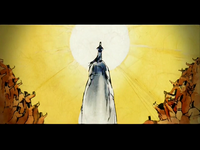
Oma founded Omashu to end the war between her and Shu's villages.
An ancient legend states that a man named Shu and a woman named Oma, each from one of two warring towns, met atop a mountain that divided their peoples and fell deeply in love. Although their relationship was forbidden and it was dangerous for them to continue meeting, the couple found a way to continue seeing each other in secrecy. By observing the badgermoles, the couple became the first earthbenders. Using their new powers, they created a great labyrinth which only they could navigate. This allowed them to meet secretly, while anyone else who tried to follow them would become lost forever in the ever-shifting tunnels.[6]
One day Shu did not come to meet Oma, nor would he ever again. Shu had been slain in the war between their two villages. Oma, stricken with grief and sorrow, performed a terrifying display of earthbending power that could have easily destroyed both villages. Instead, she declared the conflict over and demanded that the two villages live in peace. The warring villages joined together and built a new city to honor the couple's love. This city eventually grew into Omashu, the name being derived from the combination of their two names. The short epitaph found on the lovers tombs deep within the cave reads only "Love is brightest in the dark".[6]
Growth and Hundred Year War
Omashu flourished by the time of Avatar Kuruk, becoming a major population and trading center. Several harbors supplied the city with goods, and one of Omashu's most important trading partners during this time was Shimsom Big Island. Following the death of Kuruk in 312 BG, King Buro of Omashu took part in the search for the next Avatar, but failed like all before him.[7] During the conquests of Chin the Conqueror, almost the entirety of the Earth Kingdom, Omashu being no exception, fell into the hands of this tyrannical warlord. The city remained under Chin's rule until his death following his confrontation with Avatar Kyoshi.[8]
Following the commencement of the Hundred Year War in 0 AG, Omashu became one of the most important centers of resistance against the advancing Fire Nation military. Omashu's main industry was producing weapons and supplies for the war effort; civilians had developed a complex and efficient mail system used to transport goods throughout the city that employed earthbending and gravity using extensive ramps and chutes. During their childhood, Bumi, who would later become King of Omashu, and Avatar Aang used the ramps as slide, something the latter invited Sokka and Katara to try one hundred years later.[1]
Fire Nation rule
- Main article: Surrender of Omashu
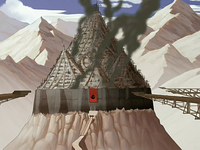
The city of Omashu fell under Fire Nation control late in the Hundred Year War and was renamed New Ozai.
Sometime after Aang, Katara, and Sokka's first visit to the city during the War, Omashu was seized by Fire Nation forces. King Bumi, always pragmatic and enigmatic, surrendered the city to the Fire Nation forces without a fight. The city was rechristened New Ozai in honor of Fire Lord Ozai by his daughter, Princess Azula, during the following spring.[4]
The entire city underwent massive reconstruction to better suit the needs of the Fire Nation. The construction of a massive statue of Fire Lord Ozai at the city's peak began, and the palace was completely leveled and replaced with the metal palace architecture favored by the Fire Nation. This may have been in part due to the fact that the old palace was designed specifically for earthbenders and as such most rooms could only be accessed through the use of earthbending. This would make entrance and exit into some of these rooms impossible for non-earthbenders. Many of the ordinary buildings were commandeered by the Fire Nation and turned into factories with chimneys protruding the top.
Ukano became the Governor of New Ozai, replacing the deposed King Bumi, who was taken into custody after surrendering the city. However, many citizens and soldiers were able to escape and form an underground resistance group.[4]
Liberation
During the Day of Black Sun, the imprisoned Bumi saw that the time to liberate the city and release himself from imprisonment had come. Following that, he proceeded to defeat the powerless firebenders and single-handedly reclaim his city from the Fire Nation; he even went as far as defiling and destroying the recently completed statue of Ozai, destroying the New Ozai palace, while laughing maniacally and eating jennamite. This was vital to the eventual liberation of the Earth Kingdom from the Fire Nation.[5]
Anarchy in the Earth Kingdom
Following Earth Queen Hou-Ting's death and the fragmentation of the Earth Kingdom, Omashu and its state continued to resist any attempts by Kuvira to integrate it into her empire for three years.[9] Shortly after the Earth Kingdom's transformation into the Earth Empire, however, Omashu yielded to her regime[2][10] and remained under her control until she was arrested following her failed attempt to annex the United Republic of Nations.[11]
Government
The city of Omashu is ruled by a king who exercises absolute control over his subjects. During the time in which Omashu was conquered by the Fire Nation, a governor was appointed by Fire Lord Ozai himself. This governor exercised both civilian and military control in the name of the Fire Nation central government, as demonstrated in his blunt ordering of all the citizens to be evacuated.[4] He was answerable only to the Fire Lord or the Royal Family.
Layout and description
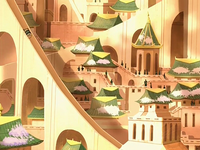
Chutes of the Omashu delivery system run throughout the city.
The city of Omashu sits within the Kolau Mountain Range, surrounded on all sides by steep canyons and an enormous gorge. The city's three gates are composed of massive blocks of stone, each five feet thick and over thirty feet tall.[12] As a result, the gates can only be opened by skilled earthbenders who guard its only entrance. The city itself is built on a number of hills. The palace sits on the tallest hill, which is centered behind some other hills. The city has thousands of houses for ordinary citizens and nobles as well as hundreds of shops, restaurants and pottery workshops. Most types of businesses in Ba Sing Se would be present in Omashu as well. The city also has a complex mail system, in which packages are transported using earthbending and gravity.[3] Buildings in Omashu are generally built from stone, unlike most buildings in the Earth Kingdom, and have green tiled roofs.
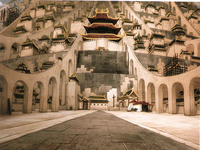
Omashu was converted into a city of steel construction during the Fire Nation's occupation.
During the Fire Nation occupation of the city, the stone was in the process of being paved over and replaced by steel; scaffoldings were a common sight. The city produced pollution as a result of the Fire Nation's technology, which produced a large amount of fumes. A massive statue of Fire Lord Ozai was constructed in the center of the city. Soldiers also patrolled the city, enforcing the new laws on the citizens. A banner depicting the Fire Nation emblem hung over the gateway leading to the city's entrance. In addition, the original earthen gate was replaced by a metal one, enabling non-earthbenders to access the city.
Locations
Royal Palace
- Main article: Omashu Royal Palace
The Omashu Royal Palace was home to the city's king prior to the city's annexation by the Fire Nation and was located at the top of the Omashu's central mountain peak. It was a palace consisting entirely of earthbending-operated doors and would be impossible for anyone, with the exception of an earthbender, to navigate it.
Omashu sewer system
The Omashu sewer system is a series of interconnected tunnels underneath the city of Omashu, used to transport water and sewage out of the city. The sewage system is a very dark and dank place full of all sorts of filth and unusual critters including the leech-a-pillar and purple pentapus. The sewer system ends at the bottom of the gorge and is one of the only ways to sneak in and out of Omashu. Aang knew about these secret passages from past experiences playing there with Bumi.[3] Aang navigated the system accompanied by Katara and Sokka when they wanted to enter the city during its occupation by the Fire Nation.[4]
New Ozai Royal Palace
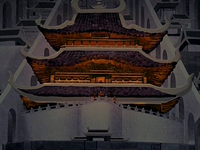
The New Ozai Royal Palace stood where the Omashu Royal Palace had previously been located.
After the Fire Nation seized control the city, the former royal palace was replaced with a new one constructed to house the governor and his family. It was situated at a lower elevation and exhibited a grand display of traditional Fire Nation architectural features. The building was three stories tall and had a tiered structure mimicking that of a temple, the uppermost tier being the smallest. Shingles covered the roof, which was red in coloration and lined by a yellow trimming along the edges. Off to the palace's sides were mail delivery lines, and the entire structure was elevated above the ground.
The palace featured many spacious balconies, which were made from yellow stone and had numerous golden ornaments that lined the railing. Ash-colored pillars supported the balcony on the second floor, and behind these pillars was a similarly toned wall bearing the building's main entrance. The second story also had a dressing room, where the palace's many cushions and baby toys were kept, though often scattered along the floor. At least two stuffed animals were stored in the room, one being a teddy bear. At the room's center lay a table where a bowl of assorted fruits would be left for the palace's residents to eat, and beside it was a brown cabinet.[4]
Mail system
- Main article: Omashu delivery system

Bumi and Aang played on the mail system.
The Omashu mail system is a linking slide that continues for miles in the city. Earthbenders move the packages around to a different slide which can travel to any place in the city. Aang and Bumi used it as a "super slide" just before the start of the War. One hundred years later, Aang used the system as a slide with Katara and Sokka, although this time, he was a bit wild, using airbending to increase their speed.[1] Aang utilized the chutes again when trying to recover the captured King Bumi from Azula.[4]
Notable figures
- † indicates deceased.
Trivia
- Based on the ancient writing in "The Cave of Two Lovers", the Traditional Chinese way to write Omashu is 奥瑪舒. 奥瑪 means "mysterious carnelian", while 舒 is a Chinese surname meaning "relax". In Simplified Chinese, Omashu is 奥玛舒.
- Omashu was built in a similar way the air temples were built, both being carved out of a mountain.
- The overall shape of Omashu is similar to that of the Chinese pictograph character for "mountain" (山).
- The triangular shape of Omashu also resembles the pyramids at Giza.
- It is also similar to the city erected on the shell of an earth lion turtle during the era of Raava.
- According to Bumi, there are no "take-backsies" in this kingdom.[1]
- The inhabitants of Omashu are free to travel anywhere within the city, unlike in the capital of Ba Sing Se.[13]
- The origin of Omashu and its name is similar to that of the Polish capital, Warsaw. According to legend, a fisherman named Wars fell in love with a mermaid named Sawa who lived in the Vistula River, and together they founded a town which was later named Warszawa (Warsaw).
- In an earlier version of Nick.com's Avatar Index, Omashu was originally referred to as Omachi,[14] though this error was later corrected.[15]
- Aang considered the people living in Omashu to be "the friendliest in the world".[1]
References
See also
- Surrender of Omashu
- Earth Kingdom
- Earthbender rebellions
- King of Omashu
- Omashu Resistance
- Omashu Royal Palace
no:Omashu